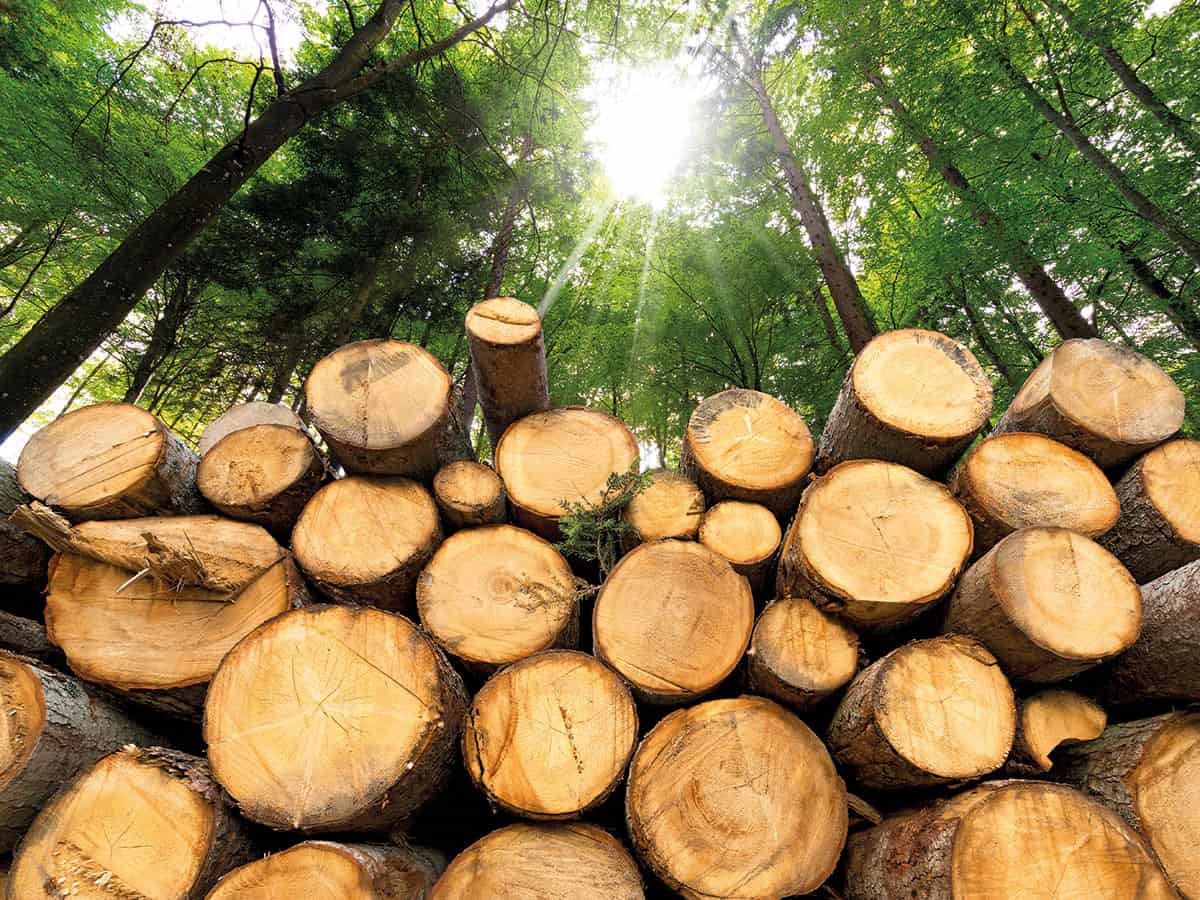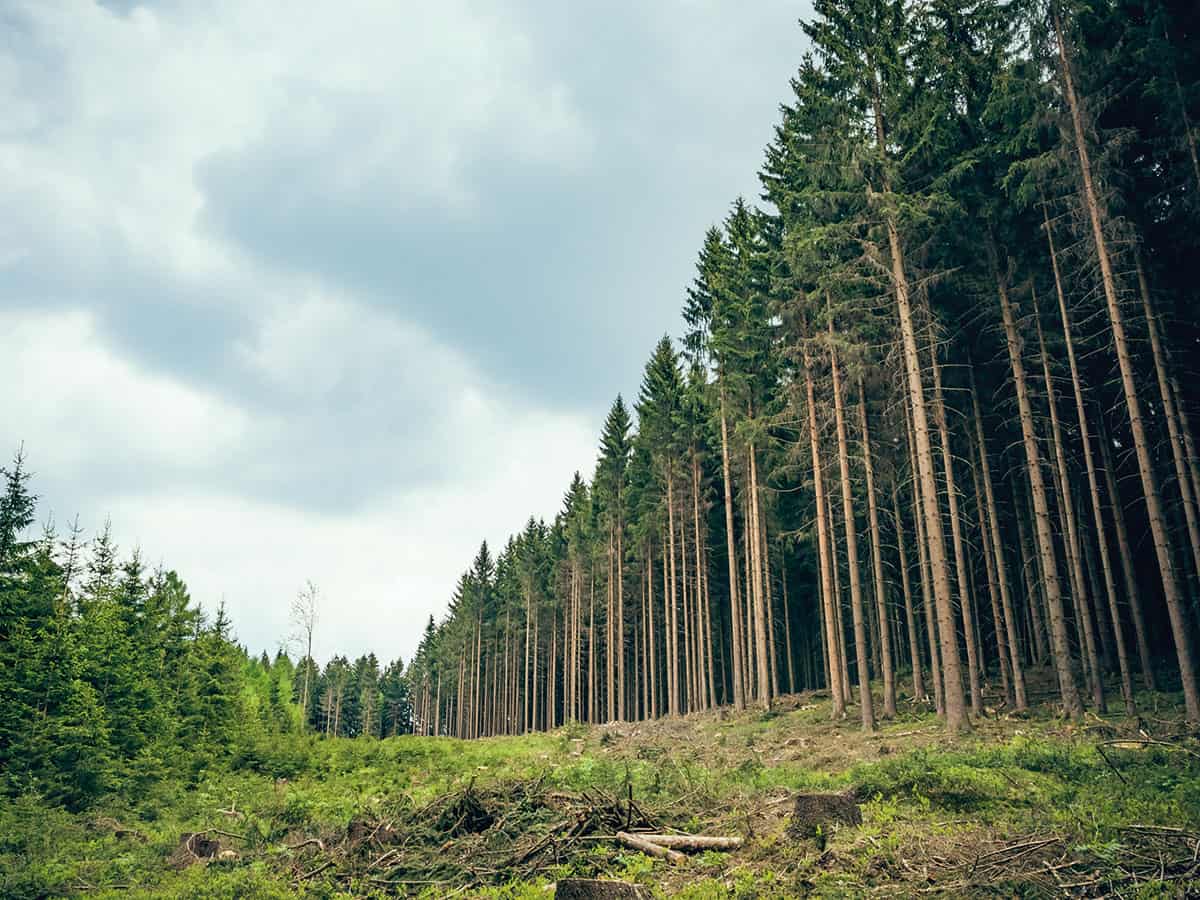The conversion to biomass energy has played a key role in reducing our dependence on fossil fuels. But is this renewable energy source really as green as we first thought? Kate Ravilious investigates

In May 2019 the UK went an entire fortnight without using any coal to generate electricity. The last time this happened, Queen Victoria was on the throne. From having had its first coal-free day in summer 2017 to recording its first coal-free week in May 2019, the UK has done an impressive job of weaning itself off the dirtiest fossil fuel. But as environmentalists cheer the good news and policy-makers give themselves a pat on the back, a terrible truth has come to light: biomass power plants – a key renewable-energy source and one of the main replacements for coal-fired power – are emitting more carbon dioxide from their smokestacks than the coal plants they have replaced. In its haste to get rid of coal, the UK may have inadvertently made global warming worse.
The logic behind biomass energy is simple. Trees and plants absorb carbon dioxide from the air, use photosynthesis to isolate the carbon, and then use it to build tree trunks, bark and leaves. But when the plant dies, it rots down and much of the carbon is released back into the atmosphere as carbon dioxide. “When we use biomass as an energy source, we are intercepting this carbon cycle, using that stored energy productively rather than it just being released into nature,” explains Samuel Stevenson, a policy analyst at the Renewable Energy Association in London.
Now as we all know, burning fossil fuels releases carbon from geological reservoirs, which would have remained locked up for many millions of years if left untouched. So switching from fossil fuels to biomass energy seemed like an obvious way for European Union (EU) nations to meet their obligations under the Paris climate agreement (signed in 2016). Back in 2009 the EU committed itself to 20% renewable energy by 2020 and included biomass on the list of renewable-energy sources, categorizing it as “carbon neutral”. Several countries embraced bioenergy and started to subsidize the biomass industry.
Currently around half the EU’s renewable energy is based on biomass, and this figure is likely to rise
Currently around half the EU’s renewable energy is based on biomass – a figure that is likely to rise. “The benefit of biomass is that it can be implemented rapidly and uses the current energy infrastructure,” says Niclas Scott Bentsen, an expert on energy systems based at the University of Copenhagen in Denmark.
In the UK, the Drax Group has led the way with this green and leafy energy revolution. Over the last decade the Drax coal-fired power station in North Yorkshire, which produces around 5% of Britain’s electricity, has seen four of its six generating units being converted to run on biomass. Today Drax generates around 12% of the UK’s renewable electricity – enough for four million households.

A massive operation
Standing next to the train track at Drax in September 2019, I watched as 25 wagons of wood pellets were slowly disgorged into one of the four Albert Hall-sized storage domes. My guide told me that most of the pellets are made from the sawmill residues and waste left over from managed forestry in the US and Canada. This can include tree tops and limbs, misshapen and diseased trees not suitable for other use, and small trees removed to maximize the growth of the forest. Virtually every day shipments arrive in ports at Immingham, Hull, Newcastle or Liverpool, each carrying around 62,000 tonnes of wood pellets – enough to keep the boilers going for two and a half days. Unloading the ship takes three days and requires 37 freight train journeys.
You might think that the greenhouse-gas emissions associated with transporting the pellets over such a vast distance must be huge, but I’m told they make up a surprisingly small proportion of the supply chain emissions. “As long as wood fuels are transported by ship, the distance doesn’t matter too much,” says Scott Bentsen.
The size of the operation at Drax is absolutely staggering. In just under two hours an entire freight-train’s worth of wood pellets goes up in smoke. Although I know that the pellets are made from sawdust and forest thinnings, I’m still struck by how colossal the demand for timber must be in order to produce leftovers on this scale. However, Drax says that by creating a market for timber waste it is helping to prevent deforestation. “Using the low-grade material for wood pellets provides the landowners with additional income, making their land more profitable and helping to incentivize them to maintain and improve the forests, rather than using the land for something else,” says a spokesperson for Drax.
According to Drax, the decision to move from coal to biomass has slashed the plant’s CO2 emissions by over 80% since 2012. “In that time, we moved from being western Europe’s largest polluter to being the home of the largest decarbonization project in Europe,” writes Will Gardiner, chief executive of Drax Group, on the company’s website.
However, those calculated savings rest on a few key assumptions: first, that the carbon released when wood pellets are burned is recaptured instantly by new growth; second, that the biomass being burned is waste that would have released carbon dioxide naturally when it rotted down. But are those assumptions right?
Advocates of biomass energy claim that when forests are harvested sustainably, and the timber industry thinnings are used as fuel, the smokestack emissions are cancelled out by the carbon absorbed by forest regrowth. However, some scientists say that this carbon accounting simply doesn’t add up. “Wood bioenergy can only reduce atmospheric CO2 gradually over time, and only if harvesting the wood to supply the biofuel induces additional growth of the forests that would not have occurred otherwise,” says John Sterman, an expert on complex systems at Massachusetts Institute of Technology (MIT) in the US. The time needed for the regrowth to mop up the additional CO2 is known as the “carbon debt payback” time, and it is this that is hotly disputed.
High hopes
Sterman – who is keen to point out that his bioenergy research is independent, funded neither by the forestry or bioenergy industry, nor environmental groups – says he was initially optimistic about biomass energy. “The climate crisis is so dire that when we began our work, I dearly hoped that wood would prove to be part of the solution,” he says. But the more he looked into it, the more concerned he became.
Using a lifecycle analysis model, Sterman and his colleagues calculated the payback time for forests in the eastern US – which supply a large share of the pellets used in the UK – and compared this figure to the emissions from burning coal. Under the best-case scenario, when all harvested land is allowed to regrow as forest, the researchers found that burning wood pellets creates a carbon debt, with a payback time of between 44 and 104 years (Environ. Res. Lett. 13 015007). “Because the combustion and processing efficiencies for wood are less than coal, the immediate impact of substituting wood for coal is an increase in atmospheric CO2 relative to coal,” Sterman explains. “This means that every megawatt-hour of electricity generated from wood produces more CO2 than if the power station had remained coal-fired.”
Sterman stresses that he is not advocating a return to burning coal. “Coal and other fossil-fuel use must fall as soon and as fast as possible to avoid the worst consequences of climate change. [But] there are many ways to do that, with improving energy efficiency being one of the cheapest and fastest.”
However, biomass energy advocates say that Sterman’s carbon debt is a fallacy, created by assessing the forest stand by stand (referring to a group of trees planted at the same time and then harvested a few decades later) rather than viewing it at the landscape level. “What actually happens is that one part of the forest is harvested (typically 3–4%) while the rest of it grows (typically net growth after harvesting is about 0.7 to 1% per year), supported by active forest management,” says Stevenson in London.
But Sterman argues that the opposite is actually true. “Harvesting one part of a growing forest does not cause trees miles away to grow even faster,” he says. “The trees harvested for bioenergy would have continued to grow, thus removing more CO2 from the atmosphere. The faster a forest is growing, the greater the future carbon storage is lost.”
It had been assumed that young trees mop up more carbon than old ones because they are fast-growing, but recent studies have revealed that ancient woodland growing in temperate regions takes up more CO2 than young plantations. This is because in some cases, growth accelerates with age and CO2 absorption is approximately equivalent to biomass (Nature 507 90). “Far from plateauing in terms of carbon sequestration at a relatively young age as was long believed, older forests (for example over 200 years of age without intervention) contain a variety of habitats, typically continue to sequester additional carbon for many decades or even centuries, and sequester significantly more carbon than younger and managed stands,” researchers write in the journal Frontiers in Forests and Global Change (2 27).

From growth to rot
But even if old trees are continuing to draw down CO2, what happens when a tree dies? Current carbon accounting assumes that all the carbon from dead wood is released back into the atmosphere again. Removing forest thinnings and burning them to produce energy is therefore viewed as better than leaving them on the forest floor to rot. Indeed, Biomass in a Low-carbon Economy – a report produced in November 2018 by the UK Committee on Climate Change – states that “Unharvested, the maintenance of these carbon stocks in perpetuity is essential to ensure that the sequestered carbon does not re-enter the atmosphere.”
However, Sterman argues that this fails to take account of the entire system. “We need to consider the carbon stored in the soil too. Removing and burning ‘waste’ wood lowers the source of carbon for forest soils. This allows soils to become net sources of carbon to the atmosphere as bacterial and fungal respiration continue to release soil carbon into the atmosphere,” he says.
Mary Booth, an ecosystem ecologist and director of the Partnership for Policy Integrity in Pelham, Massachusetts, shares Sterman’s concerns. In 2017 she used a model to calculate the net emissions impact – the difference between combustion emissions and decomposition emissions, divided by the combustion emissions – when forestry residues are burned for energy. “It is the percentage of combustion emissions you should count as being ‘additional’ to the CO2 the atmosphere would ‘see’ if the residues were just left to decompose,” she explains. Her calculations revealed that even if the pellets are made from forestry residues rather than whole trees, combustion produces a net emissions impact of 55–79% after 10 years (Environ. Res. Lett. 13 035001). Even after 40 years her model shows that net emissions are still 25–50% greater than direct emissions. Like Sterman, Booth concludes that it takes many decades to repay the carbon debt, and she concludes that biomass energy can’t be considered carbon neutral in a timeframe that is meaningful for climate-change mitigation.
Booth was so concerned by what she found that she co-ordinated a lawsuit against the EU in March 2019 (eubiomasscase.org), challenging its treatment of forest biomass as a climate-friendly renewable fuel. “Our position is that policies should count biogenic carbon emissions, and burning forest wood for fuel should not be eligible for renewable-energy subsidies,” says Booth. Currently she is waiting to hear if the court will accept the case.
Danish methods
But even if biomass energy isn’t 100% carbon neutral, there may still be a place for it in the energy mix. Currently around two-thirds of renewable energy in Denmark is provided by biomass, and it plays a vital role in keeping district heating systems running, particularly when the wind fails to blow.
In 2018 Scott Bentsen in Copenhagen calculated the carbon debt and payback time for a combined heat and power generation plant in Denmark. His results suggested that the carbon debt was paid back after just one year, and that after 12 years greenhouse-gas emissions were halved relative to continued coal combustion (Energies 11 807). These numbers are vastly different to the 40-plus years of payback time estimated by Sterman, so what makes Danish biomass energy different to the kind of process seen at Drax?
Calculating the carbon payback time for a specific supply chain can play a significant role in helping to fine-tune management practices and minimize emissions
Scott Bentsen explains that there are a number of key differences. In this Danish study, the plant burns wood chips rather than pellets, which reduces processing energy. Furthermore, the wood is sourced locally from mixed forests in a cold temperate region, which have different growing characteristics from trees in a warm temperate region. And the energy it produces is maximized, producing both heat for local houses and electricity. “Obviously we shouldn’t cut down all forests just to burn them for energy purposes, but as long as we can harvest biomass in a way that doesn’t permanently jeopardize the forest’s carbon storage and its ability to grow, then it makes scientific and climatic sense to use biomass to displace fossil-fuel resources,” says Scott Bentsen. He believes that calculating the carbon payback time for a specific supply chain can play a significant role in helping to fine-tune the management practices and minimize emissions from individual biomass energy plants (Renewable and Sustainable Energy Reviews 73 1211).
Sterman accepts that there are arguments for using timber industry waste as a biofuel. “It’s not wrong to use sawmill residues for energy, but these sources are already fully utilized. There is not enough timber industry waste to allow the biomass-energy industry to grow without using more roundwood,” he explains.
Getting more out of biomass

Simon McQueen Mason, a biologist from the University of York, UK, thinks that simply burning biomass is missing a trick. “Just using it to generate heat and electricity seems like a waste of a really good resource,” he says. Instead, McQueen Mason is investigating ways of making gas and liquid fuel from biomass, by getting micro-organisms and bacteria to munch their way through woody material, and collecting the resulting gas and liquid produced as the bugs digest the biomass. Pilot plants using sugar cane residue are already proving promising and could provide a solution to the vexing problem of de-carbonizing the petrochemical industry. “We’ve done a good job in reducing emissions from heat and electricity, but we’ve barely touched our emissions from transport,” he says. “Biofuel is probably the only way we can decarbonize the aviation industry in the next hundred years or so.”
Others suggest that this “waste” biomass might have other more valuable uses (see box, above), but right now burning it is providing governments with a quick-fix way to reduce emissions. Despite the obvious smoke belching out of the boiler chimney at Drax, the EU’s classification of biomass as a renewable form of energy means that the UK government can ignore the carbon dioxide being produced here and assume it will be mopped up by trees on the other side of the ocean. Making use of this form of carbon “loan” has played a significant role in reducing reported emissions across the EU, with figures suggesting that the EU will exceed its target of reducing greenhouse emissions by 20% by 2020. This form of carbon accounting is undermined by guidance published in November 2018 by the UK Committee on Climate Change, which concluded that there is a limited supply of sustainable biomass and that “no further policy support (beyond current commitments) should be given to large scale biomass plants that are not deployed with carbon capture and storage technology”.
But even if living trees can claw back these carbon-dioxide emissions relatively quickly, there is a danger in front-loading our emissions in this way. “Regrowth is not certain,” says Sterman. “Forest land may be converted to other uses such as pasture, agricultural land or development. And even if it remains as forest, wild fire, insect damage, disease and other ecological stresses including climate change itself may limit or prevent regrowth, so that the carbon debt incurred by biomass energy is never repaid.”



